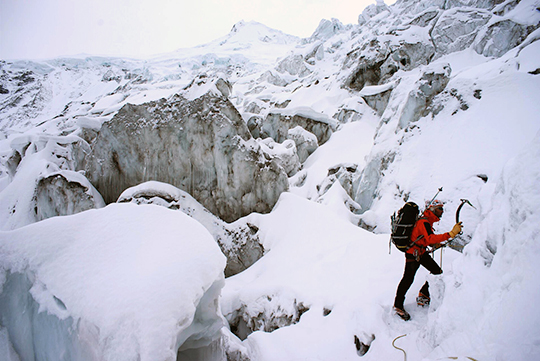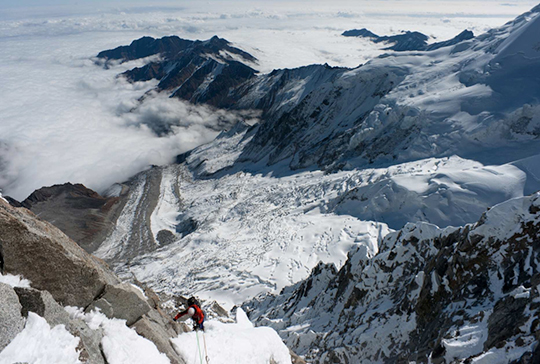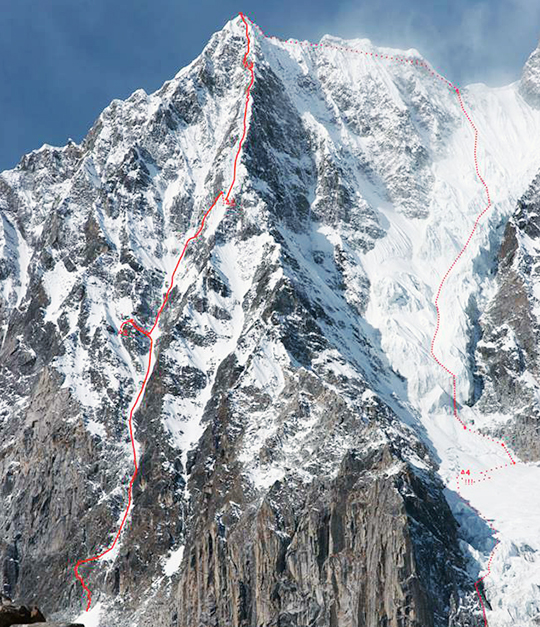
[Photo] Wojciech Ryczer
Three Polish alpinists, Marcin Rutkowski, Wojciech Ryczer and Rafal Zajac, filled in another blank space on the map of China’s Minya Konka massif with their five-day ascent of San Lian Southeast (6250m), an unclimbed mountain in the Daxue Range in western Sichuan near Tibet.
The three climbers first heard of the peak in Japanese explorer and photographer Tamotsu Nakamura’s 2012 article about Sichuan’s best-unclimbed mountains in the Japanese Alpine News. Ryczer says they were unable to find any documented attempts of the peak, although they heard rumors of an unsuccessful Korean expedition.

[Photo] Rafal Zajac
[Read “Nakamura: Sichuan’s Most Outstanding Unclimbed Peaks” in a NewsWire from June 2010–Ed.]
The three climbers flew from Poland to Chengdu on October 15, then traveled to Hailuogou National Glacier Forest Park and the mountain. They ferried gear to base camp at 4150 meters and acclimatized by establishing advance base camp below a crevassed glacier and San Lian peak.
The team wrote in a trip report: “Finding a safe route through the huge and cracked glacier was–next to acclimatizing–our primary task at this stage of the expedition.” After negotiating a route up the glacier, they considered the best route to the summit. “The south face looked more interesting than the north face,” said Ryczer, “with delicate climbing and several mixed pitches.”
Ryczer led the first pitch, dry tooling (M7) up dry, solid rock, on the afternoon of November 6 and fixed a rope. They bivouacked that night in a tent below the wall, intending to start in the morning. The following day they ascended their fixed line, then climbed several dry rock pitches to a section of delicate ice. They spent the afternoon climbing technical, vertical mixed terrain, interspersed with lower-angle rock, which they simulclimbed. The team deviated from their line of ascent in order to reach a suitable bivy spot.

[Photo] Wojciech Ryczer
On the third day, after coming back to the original line and climbing another ice section, they continued up a wide, snowy section to reach a rock barrier by easy dry tooling. That evening they rappelled to a spacious bivouac ledge below a snow-filled couloir they thought would lead to the summit.
The next morning they climbed rock sections whenever possible to avoid loose, unconsolidated snow. “We were thinking that the next section would be easier than the lower part of the face, but…we found that this snowy couloir was quite steep,” Ryczer said. “The snow was not solid, and there was no ice.” By midday, the trio reached a ridge, then continued climbing to a sitting bivy on a small ledge. Here, Ryczer dropped his sleeping bag. He spent the night wrapped in a tent for warmth.
On the fourth day, November 10, the team climbed another 4 pitches, reaching the summit at 2 p.m. To descend, they traversed the summit ridge and began rappelling down to the glacier. At 3 a.m., halfway through the descent, Zajac fell into a crevasse. His fall was arrested by his teammates who built anchors, so Rafal was able to climb back out independently using ascenders. Soon after his fall, the team bivied again to avoid more incidents, continuing the descent in daylight and returning to advanced base camp by midday.

They rated their south face route ED2 M7 WI5 R, 1450 meters. Despite the Polish expedition’s success, San Lian’s Northwest (6368m) and Central peaks (6350m) remain unclimbed, along with several higher peaks in the Minya Konka massif, including Longshan (6684m) and Mt. Chu (6468m).
Wojciech Ryczer, alpinist.com, jac.or.jp, pza.org.pl